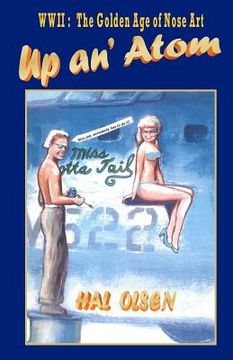Synopsis "up an' atom"
Up an' Atom: WW II The Golden Age of Nose Art Color Version, includes over 40 examples of historic paintings and photographs, by 92 Year-Old Navy Veteran and Artist, Hal Olsen. Hal Olsen, the last living World War II Nose Art visual artist, known and honored internationally for his artwork, describes in his autobiography, Up An' Atom, a critical time in his life as a young man growing up in New Jersey and serving in the United States Navy during World War II. He tells about how he began painting his way into history over 70 years ago using bare buns and bust lines to lift the spirits and morale of American aviators. An enemy bombing, blowing up a fellow artist's paint supply, and having $50.00 worth of his own oil paints, launched Hal into his Nose Art painting career while on a Mariana island in the Pacific, serving as a 3rd Class Aviation Machinist Mate in the U.S. Navy. Nose Art, a form of artistic graffiti painted on the nose of airplanes, began to flourish in the time known as the Great War-World War I (1913-1918). During the World War II years, (1941-1945), Nose Art expanded in many forms to almost every flying aircraft in the American military and is still visible on many of today's military aircraft. Hal did Nose Art on an F-111 at Pease Air Force Base in New Hampshire in 1989, painting Necessary Evil on the inside of the front wheel well flap. Hal Olsen also painted other forms of fine art to include landscapes, portraits and military items such as Navy ships, and three of his most famous paintings, the Enola Gay, Bochscar and Up An' Atom, are of the three B-29 bombers involved in the atomic bomb drops on Japan in 1945. 'The final painting I made was Enola Gay because the Air Force wanted her done right.' Photographs of his aret are included in this edition. Many paintings are in permanent museum collections with some pieces being held in private collections. Included are the U.S. Navy; Museum of New Mexico, -Santa Fe; Roswell Museum, Roswell, New Mexico; and the Los Alamos Scientific Laboratory Science Museum, Los Alamos New Mexico. Hal's artwork is also featured in Galerie Des Mondes (the Worlds Gallery) John F. Kennedy Airport, New York City, New York; the Fine Arts Museum of Santa Fe, New Mexico; Jonson Gallery, University of New Mexico, Albuquerque, New Mexico; the Commemorative Air Force American Air Power Heritage Museum, Midland, Texas; Admiral Nimitz Museum, Fredericksburg, Tennessee; the National Atomic Museum, Albuquerque, New Mexico; Los Alamos Historical Museum, Los Alamos, New Mexico and the War in the Pacific National Historical Park, Guam His awards include the Prix de Paris, received in 1961 at the Duncan Gallery in Paris, France, and first Prize for his exhibit in the World Wide Nuclear Art Exhibition, Washington D.C. He also served on the State Art Council and the Artist Advisor Commission of the Museum of New Mexico. In stressful situations, such as a war, man has a natural tendency to identify himself in unique ways and a graffiti art form of painting came into being, ultimately transferring to military aircraft as early as World War I. This decoration, usually located near the aircraft's nose, became known as Nose Art. Thousands of young men volunteered for the armed servicesafter the Pearl Harbor attack. The conflict in the Pacific continued on until August, 1945, when two U.S. Air Force B-29s ended the war by dropping atomic bombs on two cities in Japan. The aircraft named Enola Gay, piloted by Colonel Paul W. Tibbets, dropped its bomb named Little Boy on Hiroshima, August 6, 1945 while Bochscar, a plane piloted by Major Charles W. Sweeney dropped the bomb Fat Man on Nagasaki, August 9, 1945. Six days later, August 15, 1945, the Japanese surrendered, ending the war. A young Navy enlisted man, Hal Olsen, had a personal connection with two aircraft making the atomic bomb runs on Japan. He painted B-29s-Enola Gay and Bochscar. This is Hal's Story.

